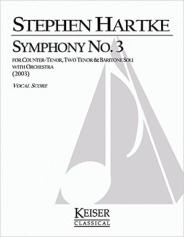
Stephen Hartke
SYMPHONY No. 3 (2003)
for Countertenor, 2 Tenor, and Baritone Soli with Orchestra
Commissioned by the New York Philharmonic and generously supported by Marie-Josee and
Henry Kravis
Duration: 28 Minutes
Orchestra
3 Flutes (3rd doubles Piccolo), 2 Oboes, English Horn, 2 B-flat Clarinets, Bass Clarinet, 3
Bassoons (3rd doubling Contrabassoon), 4 Horns, 4 Trumpets, 4 Trombones, Tuba, 3
Percussionists (Vibraphone, Marimba, Bass Drum, Chinese Opera Cymbals, Large Crash
Cymbals, Medium Crash Cymbals, 4 Noah Bells in E, E-flat, D-flat and A-flat), Timpani,
Piano doubling Celesta, Harp, Strings
When I was offered the commission to write a new symphony for Lorin Maazel and the
New York Philharmonic and came to know that it would be having its premiere within a
week of the 2nd aniversary of the September 11th attack, I decided to do a work which,
while not specific to the occasion, would nonetheless reflect on the event from what I
hope is an unusual perspective. I turned to a text I had been wanting to set for almost
thirty years: an Old English elegy, perhaps one of the oldest surviving Old English
poems, from the 8th or 9th centuries. In it the poet describes the ruins of a Roman city
(perhaps Bath), contrasting the decay he sees with imaginings of the splendor that once
was. What is particularly striking about the text is that it does not moralize, as later
memento mori poems do, but rather celebrates the creative spirit of the city's vanished
inhabitants. The text is somewhat fragmentary owing to the age of the volume in which
it was found and the damage it had sustained. Thus the poem fades in and out, and the
actual ending is entirely missing (though the final surviving line, "That was spacious",
provides a satisfying close). The symphony is cast in a single movement, but clearly
divided into four main sections, the slower ones (the first and the third) treat the
descriptions of the ruined city, and the faster ones are the evocations of the greatness of
the city at its height. This work is also my third one for the Hilliard Ensemble with whom
I had previously collaborated on two extended chamber pieces, Tituli and Cathedral in the
Thrashing Rain. Both of these are also about the palpable connection with the past that
carved stone yields us, and as with this symphony, they partake of the spirit of sacred
music though from a decidedly humanist point of view.
The Ruin
(Anonymous Anglo-Saxon poet, 8th-9th c. CE - translated and adapted by the composer)
Wondrous is this wall-stone, broken by fate.
The castles have decayed: the work of giants crumbles.
Roofs are ruined, towers toppled,
gates rusted and broken, hoar frost clings to the mortar.
Broken are the roof-beams, cut away, collapsed, undermined by age.
The grasp of the earth, stout grip of the ground,
holds its mighty builders, who have perished and gone. …
Oft this wall-stone, grey with lichen and stained with red,
has withstood storms, surviving kingdom after kingdom.
Its lofty gates have fallen …
Yet still this wall-stone stands, weathered by wind and storm.
Bold builders bound the foundation wondrously together with wires.
Bright were these city-dwellings: many the bath-houses,
lofty the great gables, thunderous the tumult of men,
many a mead-hall filled with the joys of men,
till Fate the mighty overturned it all.
The wide walls fell, days of pestilence came.
Death swept away all the bravery of men.
Their temples became waste places:
the city fell to ruin. The multitudes who might have built it anew
lay dead upon the earth. Therefore these courts have crumbled away
and these lofty gates. The slates slide
from the red-vaulted roofs. The place has sunk into ruin,
broken into a heap.
Here in times past many a man
light of heart, gleaming with gold, adorned with splendors,
proud and flushed with wine, shone in war trappings,
gazed on treasure, on silver, on precious stones,
on riches, on possessions, on costly gems,
in this brilliant city of the broad kingdom.
Stone courts stood here: the stream with its great gush
leapt forth, hot. The wall encircled it all
within its bright bosom. There the baths were,
hot at its heart …
That was spacious

Recording:
New York Philharmonic
The Hilliard Ensemble
Lorin Maazel, Conductor
New World Records
80648-2















YouTube:
New York Philharmonic
The Hilliard Ensemble
Lorin Maazel, Conductor